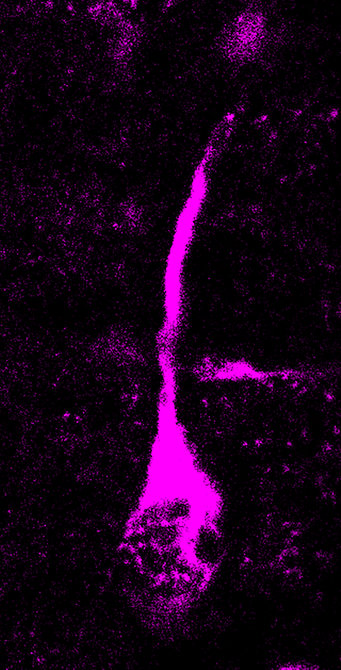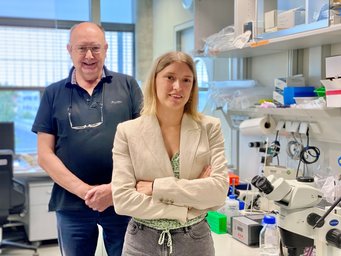Modern humans generate more brain neurons than Neanderthals
Due to the change of a single amino acid, brain evolution has proceeded differently
While both Neandertals and modern humans develop brains of similar size, very little is known about whether modern human and Neandertal brains may have differed in terms of their neuron production during development. Researchers from the Max Planck Institute of Molecular Cell Biology and Genetics (MPI-CBG) in Dresden now show that the modern human variant of the protein TKTL1, which differs by only a single amino acid from the Neandertal variant, increases one type of brain progenitor cells, called basal radial glia, in the modern human brain.

Basal radial glial cells generate the majority of the neurons in the developing neocortex, a part of the brain that is crucial for many cognitive abilities. As TKTL1 activity is particularly high in the frontal lobe of the fetal human brain, the researchers conclude that this single human-specific amino acid substitution in TKTL1 underlies a greater neuron production in the developing frontal lobe of the neocortex in modern humans than Neandertals.
Only a small number of proteins have differences in the sequence of their amino acids – the building blocks of proteins – between modern humans and our extinct relatives, the Neandertals and Denisovans. The biological significance of these differences for the development of the modern human brain is largely unknown. In fact, both, modern humans and Neandertals, feature a brain, and notably a neocortex, of similar size, but whether this similar neocortex size implies a similar number of neurons remains unclear.
The latest study of the research group of Wieland Huttner, one of the founding directors of the Max Planck Institute of Molecular Cell Biology and Genetics (MPI-CBG) in Dresden, carried out in collaboration with Svante Pääbo, director at the Max Planck Institute for Evolutionary Anthropology in Leipzig, and Pauline Wimberger of the University Hospital Dresden and their colleagues, addresses just this question.
Arginine instead of lysine
The researchers focus on one of these proteins that presents a single amino acid change in essentially all modern humans compared to Neandertals, the protein transketolase-like 1 (TKTL1). Specifically, in modern humans TKTL1 contains an arginine at the sequence position in question, whereas in Neandertal TKTL1 it is the related amino acid lysine. In the fetal human neocortex, TKTL1 is found in neocortical progenitor cells, the cells from which all cortical neurons derive. Notably, the level of TKTL1 is highest in the progenitor cells of the frontal lobe.
Anneline Pinson, the lead author of the study and researcher in the group of Wieland Huttner, set out to investigate the significance of this one amino acid change for neocortex development. Anneline and her colleagues introduced either the modern human or the Neandertal variant of TKTL1 into the neocortex of mouse embryos. They observed that basal radial glial cells, the type of neocortical progenitors thought to be the driving force for a bigger brain, increased with the modern human variant of TKTL1 but not with the Neandertal variant. As a consequence, the brains of mouse embryos with the modern human TKTL1 contained more neurons.

After this, the researchers explored the relevance of these effects for human brain development. To this end, they replaced the arginine in modern human TKTL1 with the lysine characteristic of Neandertal TKTL1, using human brain organoids – miniature organ-like structures that can be grown from human stem cells in cell culture dishes in the lab and that mimic aspects of early human brain development.
“We found that with the Neandertal-type of amino acid in TKTL1, fewer basal radial glial cells were produced than with the modern human-type and, as a consequence, also fewer neurons,” says Anneline Pinson. “This shows us that even though we do not know how many neurons the Neandertal brain had, we can assume that modern humans have more neurons in the frontal lobe of the brain, where TKTL1 activity is highest, than Neandertals."
Changes in metabolism
The researchers also found that modern human TKTL1 acts through changes in metabolism, specifically a stimulation of the pentose phosphate pathway followed by increased fatty acid synthesis. In this way, modern human TKTL1 is thought to increase the synthesis of certain membrane lipids needed to generate the long process of basal radial glial cells that stimulates their proliferation and, therefore, to increase neuron production.
"Based on these results, one can assume that the formation of neurons in the neocortex during foetal development is greater in modern humans than in Neanderthals, mainly in the frontal lobe," summarises Wieland Huttner, who led the study. "It is quite conceivable that this has promoted the cognitive abilities of modern humans, which are based on the frontal lobe."













